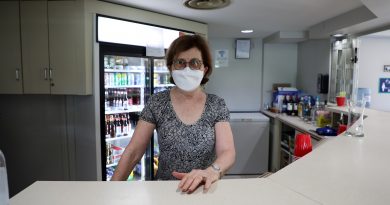COVID-19 hospitalizations up three times since New Year’s Day
Special to WC Online
OTTAWA – Hospitalizations due to COVID-19 have risen three times New Year’s Day levels 12 days ago.
There are now 33 patients in Ottawa hospitals being treated for COVID-19 and 11 novel coronavirus patients are in intensive care, as of Tuesday, Jan. 12.
Ottawa Public Health (OPH) is reporting 63 new COVID-19 cases in the city today (Jan. 12), with no new deaths related to the virus.
With Tuesday’s single-day case count coming in below average compared to recent weeks, the local active case number has dropped slightly, to 1,157. OPH reported more than 1,200 active cases in Ottawa, Monday.
The city’s pandemic death toll at 398.
Outbreaks of COVID-19 are affecting 31 healthcare facilities, Tuesday, with one staff member at a group home the latest to contract the virus and cause it to go into ‘outbreak’ status. One school or childcare facility is still experiencing an outbreak of the virus, while OPH continues to track nine community outbreaks. One is linked to a social event; one from sports and recreation; another from a multi-unit dwelling; while the rest are tied to workplaces.
There have been 11,568 lab-confirmed cases of COVID-19 in Ottawa since March of 2020, of which 10,013 are resolved.
Ontario is reporting 2,903 new cases of COVID-19, Tuesday, with 41 new deaths. That count includes 18 in the Eastern Ontario Health Unit, four in Leeds, Grenville and Lanark, and one in Renfrew County.
Ontario’s long-term care sector continues to be devastated by the COVID-19 pandemic and ICU occupancy is increasing with “real consequences for health” among the key findings in the province’s latest round of COVID-19 data and modelling.
Ontario health officials say almost 40 per cent of long-term care homes are reporting active COVID-19 outbreaks and since Jan. 1, a total of 198 residents and two staff members have died from the virus.
The latest forecast suggests there will be more deaths across the province’s long-term care sector in the second wave than the first.
Under what the province labels “worst-case scenario,” deaths among residents of Ontario long-term care homes could reach more than 2,600 by Feb. 14.
Today, health officials confirmed ICU occupancy is now over 400 beds in the province with more surgeries being cancelled as a result.
Projections put ICU occupancy around 500 beds by mid-January with the potential of more than 1,000 beds in February, “in more severe but realistic scenarios.”
Over the past two weeks, there has been an average of 2.34 per cent daily case growth in Ontario.
“The access to care deficit will continue to increase with real consequences for health,” health officials wrote.
In December, the province said, under the worst-case scenario, “Ontario will see more than 1,500 beds occupied in ICUs by mid-January.”
Health officials say that the daily mortality rate continues to increase despite the current level of restrictions. As a result, they say the daily number of deaths could double from around 50 to 100 people per day from now until the end of February.
The province is reporting a 72.2 per cent increase in hospitalizations over the past four weeks with a 61.2 per cent increase in ICU patients.
Additionally, one-quarter of hospitals have no ICU beds free, while another quarter only has one to two beds free as a result of the pandemic.
The province says, “mobility and contacts between people have not decreased with the current restrictions” showing that despite many public health units being placed under Ontario’s ‘Grey-Zone’, there was a pre-holiday spike in numbers.
According to survey data, the majority of Ontarians are helping limit spread by following health and safety measures as well as lockdown restrictions.
“However, case numbers will not decline until more of the population follows their example,” the province said.
The survey data finds almost two-thirds of the population is acting in a way that will decrease COVID-19 spread.











